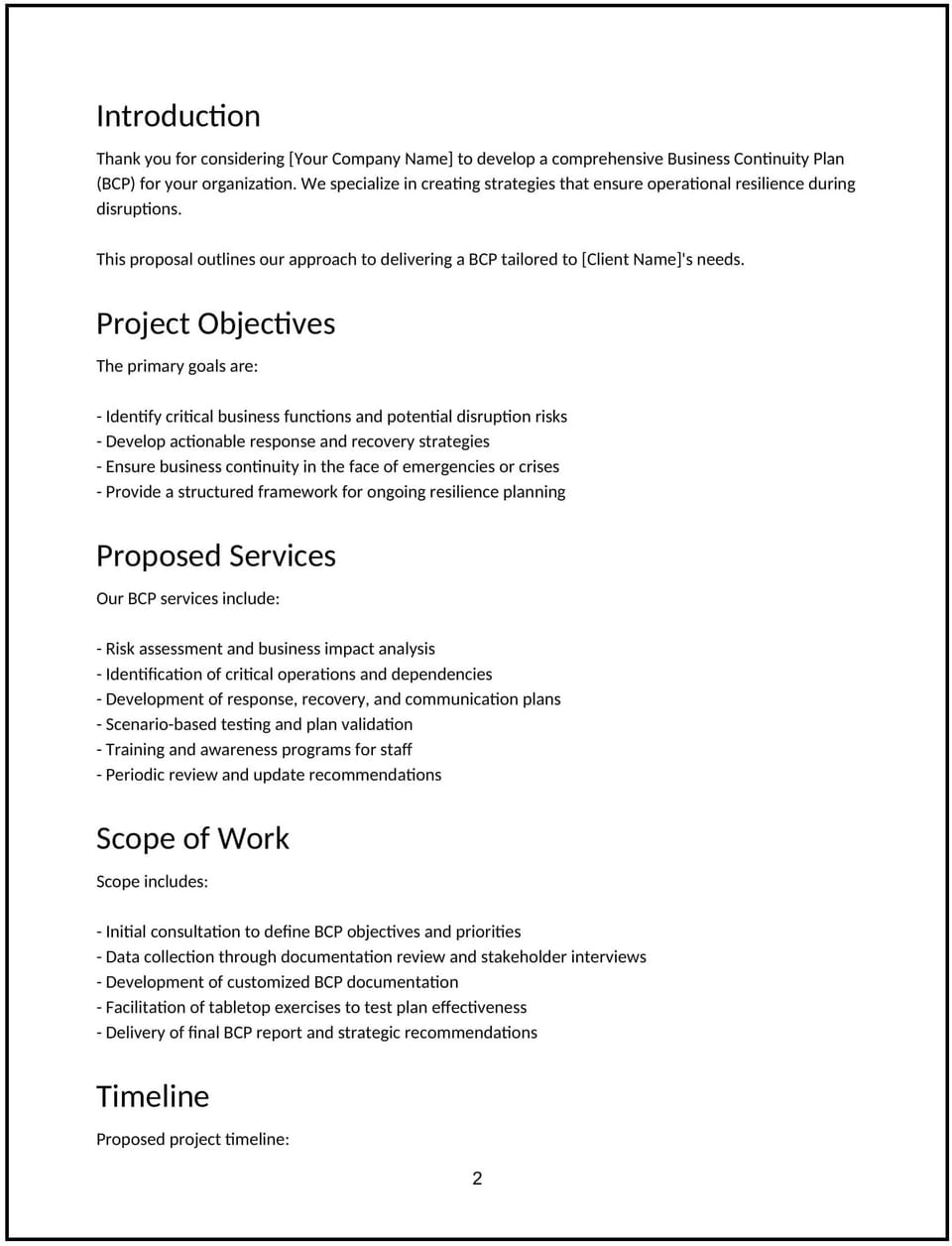Business continuity planning proposal: Free template

Customize this free business continuity planning proposal with Cobrief
Open this free business continuity planning proposal in Cobrief and start editing it instantly using AI. You can adjust the tone, structure, and content based on your client’s size, risk profile, and industry requirements. You can also use AI to review your draft — clarify scope, flag missing components, and improve structure before sending.
Once you're done, send, download, or save the proposal in one click — no formatting or setup required.
This template is fully customizable and built for real-world use — ideal for businesses preparing for operational disruptions, regulatory audits, or internal risk reviews. Whether you're advising a startup, enterprise, or nonprofit, this proposal helps you communicate your planning process clearly and secure buy-in from decision-makers.
What is a business continuity planning proposal?
A business continuity planning proposal outlines how you’ll help a client develop strategies and documentation to continue operations during and after unexpected disruptions — such as cyberattacks, natural disasters, system failures, or key personnel loss.
It includes your scope of work, timeline, deliverables, and pricing. This type of proposal is used by risk consultants, IT advisors, operations teams, and legal professionals offering BCP (Business Continuity Plan) services. It differs from general risk audits by focusing on operational recovery, contingency protocols, and role-based action plans.
It’s especially valuable for businesses facing regulatory pressure, contractual obligations, or increased operational risk due to growth or digital dependency.
Why use Cobrief to edit your proposal
- Edit the full proposal instantly: Skip formatting tools and get straight to customization.
- Use AI to tailor your scope: Adjust for different industries, risk levels, or continuity planning maturity.
- Run an AI-powered review: Catch missing phases, vague language, or inconsistent deliverables before sending.
- Accept edits in one click: Apply all or selected changes automatically.
- Save, send, or download: Export a clean, professional version in seconds.
When to use this proposal
- When helping a business develop or refresh its business continuity plan
- When responding to regulatory audits, investor requirements, or procurement requests
- When offering continuity planning alongside cybersecurity or compliance services
- When onboarding new leadership or advising during structural transitions
- When conducting a proactive risk mitigation initiative with the legal, ops, or IT team
What to include in a business continuity planning proposal
- Project overview: Describe the purpose of the engagement — such as minimizing downtime, protecting revenue, or satisfying compliance requirements. Tailor this to the client’s operational risks and business context.
- Scope of work: List all services included — such as risk assessment, impact analysis, recovery strategy design, role mapping, communication planning, testing protocols, and final plan documentation. Clarify whether you’ll provide facilitation, templates, or live workshops.
- Timeline: Provide a clear delivery schedule — from discovery and stakeholder interviews to plan development, review cycles, and final sign-off.
- Deliverables: Specify what the client will receive — typically a complete BCP document, process maps, incident playbooks, recovery checklists, and optional training or tabletop testing materials.
- Pricing: Outline your fee — as a flat project rate, hourly consulting, or phased pricing. Note if post-implementation support, periodic updates, or compliance testing are included or available separately.
- Call to action / next steps: Close with a direct prompt — approve the proposal, confirm scope, or schedule a kickoff call. Keep it clear and easy to act on.
How to write an effective business continuity planning proposal
- Speak to resilience, not just compliance: Show how continuity planning protects business value, not just checklists.
- Break the process into clear stages: Help the client understand how the work flows from risk to readiness.
- Avoid generic language: Use examples relevant to the client’s sector, such as supply chain risks for manufacturers or data access for SaaS.
- Emphasize practicality: Clients want a plan they can actually use — not just a document for the shelf.
- Define ownership clearly: Clarify who owns updates, triggers, and testing responsibility.
- End with confidence: Always close with a next step that moves the proposal forward.
Frequently asked questions (FAQs)
What’s included in a typical business continuity plan?
Most BCPs include a risk assessment, business impact analysis, recovery procedures, communication strategies, and assigned roles. This proposal can include the full process or selected phases depending on client needs.
Can I use this proposal for a specific department or team?
Yes — you can tailor the scope for IT, HR, finance, or location-specific continuity planning.
Can this include testing or simulations?
Absolutely. You can include tabletop exercises, readiness scoring, or follow-up testing protocols in the scope or as add-ons.
Is this proposal suitable for small businesses?
Yes — the proposal can be adjusted to offer lightweight, actionable continuity plans for lean teams or startups.
Does this proposal replace a legal agreement?
No — this outlines your services and pricing. A formal engagement letter or contract should follow if the client approves.
This article contains general legal information and does not contain legal advice. Cobrief is not a law firm or a substitute for an attorney or law firm. The law is complex and changes often. For legal advice, please ask a lawyer.